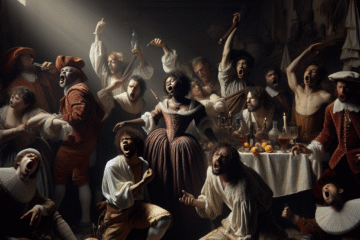Rembrandt Harmenszoon van Rijn (1606-1669) was a Dutch painter and etcher who is generally considered one of the greatest painters and printmakers in European art history and the most important in Dutch history. His contributions to art came in a period of great wealth and cultural achievement that historians call the Dutch Golden Age, when Dutch art (especially Dutch painting), although in many ways antithetical to the Baroque style that dominated Europe, was extremely prolific and innovative.
Born in Leiden, Rembrandt received his artistic training from his father and from the artist Jacob van Swanenburgh. He began his career as a painter of historical and biblical scenes, but later gained fame for his portraits and genre scenes, which depicted everyday life in a realistic and expressive manner.
One of Rembrandt’s most famous works is “The Night Watch,” a large group portrait that depicts a company of militia on patrol. This painting is notable for its dramatic use of light and shadow and its sense of movement and action.
In addition to his paintings, Rembrandt was also an accomplished etcher. His etchings, which number over 300, include portraits, landscapes, and biblical and mythological scenes. His work as an etcher helped to establish his reputation as an artist and contributed to the development of the medium of printmaking.
Throughout his career, Rembrandt faced financial struggles and was forced to sell his possessions, including his house and most of his paintings, to pay off debts. Despite these challenges, he continued to produce work until his death in 1669 at the age of 63.
Rembrandt’s work has had a lasting impact on the art world and continues to be admired and studied by art enthusiasts today. His innovative use of light and shadow and his ability to capture the human soul in his portraits have made him one of the most beloved and influential artists in history.
Some of Rembrandt’s most famous artworks include:
- “The Night Watch” (1642): This large group portrait depicts a company of militia on patrol. It is notable for its dramatic use of light and shadow and its sense of movement and action.
- “The Jewish Bride” (1665): This portrait depicts a couple in a tender embrace, with the man holding a jewelry box as a symbol of the bride’s dowry. It is considered one of Rembrandt’s masterpieces and is known for its intimate and emotional portrayal of the couple.
- “The Anatomy Lesson of Dr. Nicolaes Tulp” (1632): This painting depicts Dr. Tulp demonstrating the dissection of a cadaver to a group of physicians. It is notable for its scientific accuracy and its dramatic use of light and shadow.
- “The Return of the Prodigal Son” (1668): This painting depicts the biblical parable of the prodigal son, with the son being welcomed back into his father’s arms after squandering his inheritance. It is known for its emotional and poignant portrayal of the father’s forgiveness and love.
- “The Jewish Cemetery” (1639): This etching depicts a scene of a Jewish cemetery, with tombstones and a mourner in the foreground. It is considered one of Rembrandt’s finest prints and is known for its dramatic use of light and shadow and its sen
Rembrandt’s art style is characterized by his innovative use of light and shadow, his attention to detail, and his ability to capture the human soul in his portraits.
One of the key features of Rembrandt’s style is his use of chiaroscuro, or the use of strong contrasts between light and dark. This technique allowed him to create a sense of depth and dimension in his paintings and etchings, and to draw the viewer’s attention to specific elements of the composition.
In his portraits, Rembrandt was known for his ability to capture the inner essence and character of his subjects. He often used expressive brushwork and detailed modeling of the face and body to convey the emotions and personality of the sitter.
Rembrandt’s work is also notable for its realism and attention to detail. He was a master at depicting the textures and details of clothing, jewelry, and other objects, and his paintings and etchings are filled with subtle nuances and nuances of light and shadow.
Overall, Rembrandt’s art style is characterized by its drama, emotion, and realism, and his ability to capture the human soul in his paintings and etchings has made him one of the most beloved and influential artists in history.

